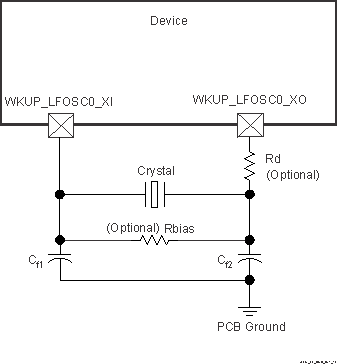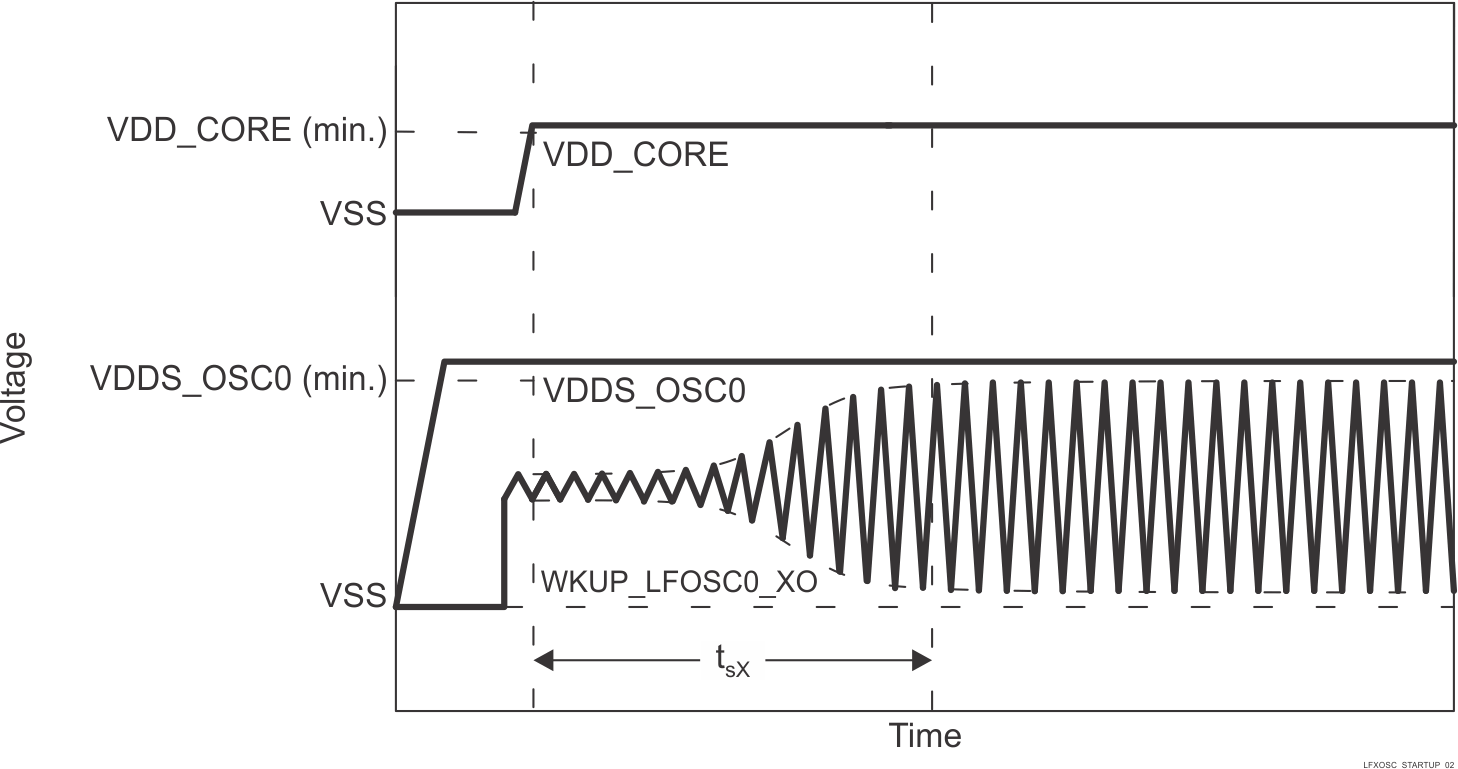SPRSP58B june 2022 – june 2023 AM620-Q1 , AM623 , AM625 , AM625-Q1
PRODUCTION DATA
- 1
- 1 Features
- 2 Applications
- 3 Description
- 4 Revision History
- 5 Device Comparison
-
6 Terminal Configuration and Functions
- 6.1 Pin Diagrams
- 6.2 Pin Attributes
- 6.3
Signal Descriptions
- 15
- 6.3.1 CPSW3G
- 6.3.2 CPTS
- 6.3.3 CSI-2
- 6.3.4 DDRSS
- 6.3.5 DSS
- 6.3.6 ECAP
- 6.3.7 Emulation and Debug
- 6.3.8 EPWM
- 6.3.9 EQEP
- 6.3.10 GPIO
- 6.3.11 GPMC
- 6.3.12 I2C
- 6.3.13 MCAN
- 6.3.14 MCASP
- 6.3.15 MCSPI
- 6.3.16 MDIO
- 6.3.17 MMC
- 6.3.18 OLDI
- 6.3.19 OSPI
- 6.3.20 Power Supply
- 6.3.21 PRUSS
- 6.3.22 Reserved
- 6.3.23 System and Miscellaneous
- 6.3.24 TIMER
- 6.3.25 UART
- 6.3.26 USB
- 6.4 Pin Connectivity Requirements
-
7 Specifications
- 7.1 Absolute Maximum Ratings
- 7.2 ESD Ratings for Devices which are not AEC - Q100 Qualified
- 7.3 ESD Ratings for AEC - Q100 Qualified Devices in the AMC Package
- 7.4 Power-On Hours (POH)
- 7.5 Recommended Operating Conditions
- 7.6 Operating Performance Points
- 7.7 Power Consumption Summary
- 7.8
Electrical
Characteristics
- 7.8.1 I2C Open-Drain, and Fail-Safe (I2C OD FS) Electrical Characteristics
- 7.8.2 Fail-Safe Reset (FS RESET) Electrical Characteristics
- 7.8.3 High-Frequency Oscillator (HFOSC) Electrical Characteristics
- 7.8.4 Low-Frequency Oscillator (LFXOSC) Electrical Characteristics
- 7.8.5 SDIO Electrical Characteristics
- 7.8.6 LVCMOS Electrical Characteristics
- 7.8.7 OLDI LVDS (OLDI) Electrical Characteristics
- 7.8.8 CSI-2 (D-PHY) Electrical Characteristics
- 7.8.9 USB2PHY Electrical Characteristics
- 7.8.10 DDR Electrical Characteristics
- 7.9 VPP Specifications for One-Time Programmable (OTP) eFuses
- 7.10 Thermal Resistance Characteristics
- 7.11
Timing and Switching Characteristics
- 7.11.1 Timing Parameters and Information
- 7.11.2 Power Supply Requirements
- 7.11.3 System Timing
- 7.11.4
Clock Specifications
- 7.11.4.1 Input Clocks / Oscillators
- 7.11.4.2 Output Clocks
- 7.11.4.3 PLLs
- 7.11.4.4 Recommended System Precautions for Clock and Control Signal Transitions
- 7.11.5
Peripherals
- 7.11.5.1 CPSW3G
- 7.11.5.2 CPTS
- 7.11.5.3 CSI-2
- 7.11.5.4 DDRSS
- 7.11.5.5 DSS
- 7.11.5.6 ECAP
- 7.11.5.7 Emulation and Debug
- 7.11.5.8 EPWM
- 7.11.5.9 EQEP
- 7.11.5.10 GPIO
- 7.11.5.11 GPMC
- 7.11.5.12 I2C
- 7.11.5.13 MCAN
- 7.11.5.14 MCASP
- 7.11.5.15 MCSPI
- 7.11.5.16
MMCSD
- 7.11.5.16.1
MMC0 - eMMC/SD/SDIO Interface
- 7.11.5.16.1.1 Legacy SDR Mode
- 7.11.5.16.1.2 High Speed SDR Mode
- 7.11.5.16.1.3 HS200 Mode
- 7.11.5.16.1.4 Default Speed Mode
- 7.11.5.16.1.5 High Speed Mode
- 7.11.5.16.1.6 UHS–I SDR12 Mode
- 7.11.5.16.1.7 UHS–I SDR25 Mode
- 7.11.5.16.1.8 UHS–I SDR50 Mode
- 7.11.5.16.1.9 UHS–I DDR50 Mode
- 7.11.5.16.1.10 UHS–I SDR104 Mode
- 7.11.5.16.2 MMC1/MMC2 - SD/SDIO Interface
- 7.11.5.16.1
MMC0 - eMMC/SD/SDIO Interface
- 7.11.5.17 OLDI
- 7.11.5.18 OSPI
- 7.11.5.19 PRUSS
- 7.11.5.20 Timers
- 7.11.5.21 UART
- 7.11.5.22 USB
-
8 Detailed Description
- 8.1 Overview
- 8.2 Processor Subsystems
- 8.3 Accelerators and Coprocessors
- 8.4 Other Subsystems
- 8.5
Peripherals
- 8.5.1 Gigabit Ethernet Switch (CPSW3G)
- 8.5.2 Camera Streaming Interface Receiver (CSI_RX_IF)
- 8.5.3 DDR Subsystem (DDRSS)
- 8.5.4 Display Subsystem (DSS)
- 8.5.5 Enhanced Capture (ECAP)
- 8.5.6 Error Location Module (ELM)
- 8.5.7 Enhanced Pulse Width Modulation (EPWM)
- 8.5.8 Error Signaling Module (ESM)
- 8.5.9 Enhanced Quadrature Encoder Pulse (EQEP)
- 8.5.10 General-Purpose Interface (GPIO)
- 8.5.11 General-Purpose Memory Controller (GPMC)
- 8.5.12 Global Timebase Counter (GTC)
- 8.5.13 Inter-Integrated Circuit (I2C)
- 8.5.14 Modular Controller Area Network (MCAN)
- 8.5.15 Multichannel Audio Serial Port (MCASP)
- 8.5.16 Multichannel Serial Peripheral Interface (MCSPI)
- 8.5.17 Multi-Media Card Secure Digital (MMCSD)
- 8.5.18 Octal Serial Peripheral Interface (OSPI)
- 8.5.19 Timers
- 8.5.20 Universal Asynchronous Receiver/Transmitter (UART)
- 8.5.21 Universal Serial Bus Subsystem (USBSS)
-
9 Applications,
Implementation, and Layout
- 9.1 Device Connection and Layout Fundamentals
- 9.2 Peripheral- and Interface-Specific Design Information
- 10Device and Documentation Support
- 11Mechanical, Packaging, and Orderable Information
7.11.4.1.3 WKUP_LFOSC0 Internal Oscillator Clock Source
Figure 7-21 shows the recommended crystal circuit. It is recommended that preproduction printed-circuit board (PCB) designs include the two optional resistors Rbias and Rd in case they are required for proper oscillator operation when combined with production crystal circuit components. In most cases, Rbias is not required and Rd is a 0-Ω resistor. These resistors may be removed from production PCB designs after evaluating oscillator performance with production crystal circuit components installed on preproduction PCBs.
 Figure 7-21 WKUP_LFOSC0 Crystal Implementation
Figure 7-21 WKUP_LFOSC0 Crystal ImplementationTable 7-23 presents LFXOSC modes of operation.
| MODE | BP_C | PD_C | XI | XO | CLK_OUT | DESCRIPTION |
|---|---|---|---|---|---|---|
| ACTIVE | 0 | 0 | XTAL | XTAL | CLK_OUT | Active oscillator mode providing 32kHz |
| PWRDN | 0 | 1 | X | PD | LOW | Output will be pulled down to LOW. PAD to be tri-stated. Active mode disabled |
| BYPASS | 1 | 0 | CLK | PD | CLK | XI is driven by external clock source. XO is pulled down to LOW. Due to ESD diode to supply, XI should not be driven unless oscillator supply is present. |
User should set CTRLMMR_WKUP_LFXOSC_TRIM[18:16] i_mult = 3b’001 for CL in the range 6pf to 9.5pf. CTRLMMR_WKUP_LFXOSC_TRIM [18:16] i_mult = 3b’010 for CL in the range 8.5pf to 12pf. Default setting is 3b’010.
The load capacitors, Cf1 and Cf2 in Figure 7-22, should be chosen such that the below equation is satisfied. CL in the equation is the load specified by the crystal manufacturer. All discrete components used to implement the oscillator circuit should be placed as close as possible to the associated oscillator WKUP_LFOSC0_XI, WKUP_LFOSC0_XO, and VSS pins.
 Figure 7-22 Load
Capacitance Equation
Figure 7-22 Load
Capacitance EquationThe crystal must be in the fundamental mode of operation and parallel resonant. Table 7-24 summarizes the required electrical constraints.
| NAME | DESCRIPTION | MIN | TYP | MAX | UNIT | |||
|---|---|---|---|---|---|---|---|---|
| fp | Parallel resonance crystal frequency | 32768 | Hz | |||||
| Cf1 | Cf1 load capacitance for crystal parallel resonance with Cf1 = Cf2 | 12 | 24 | pF | ||||
| Cf2 | Cf2 load capacitance for crystal parallel resonance with Cf1 = Cf2 | 12 | 24 | pF | ||||
| Cshunt | Shunt capacitance | ESRxtal – 40 kΩ | 4 | pF | ||||
| ESRxtal – 60 kΩ | 3 | pF | ||||||
| ESRxtal – 80 kΩ | 2 | pF | ||||||
| ESRxtal – 100 kΩ | 1 | pF | ||||||
| ESR | Crystal effective series resistance | (1) | Ω | |||||
When selecting a crystal, the system design must consider the temperature and aging characteristics of a based on the worst case environment and expected life expectancy of the system.
Table 7-25 details the switching characteristics of the oscillator and the requirements of the input clock.
| NAME | DESCRIPTION | MIN | TYP | MAX | UNIT |
|---|---|---|---|---|---|
| fxtal | Oscillation frequency | 32768 | Hz | ||
| tsX | Start-up time | 96.5 | ms |
 Figure 7-23 WKUP_LFOSC0 Start-up Time
Figure 7-23 WKUP_LFOSC0 Start-up Time